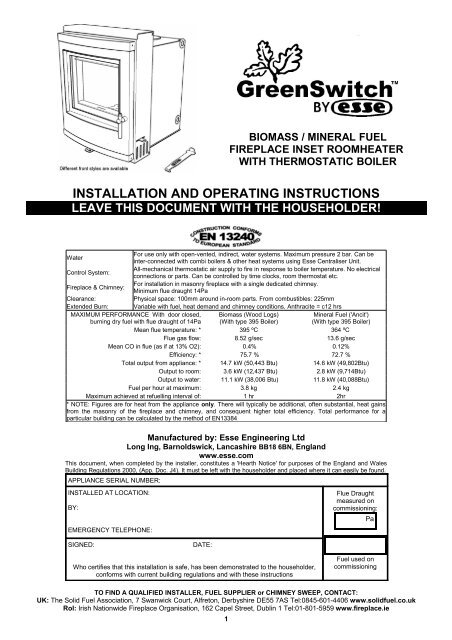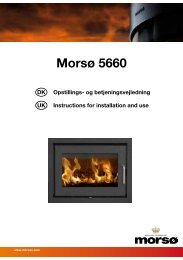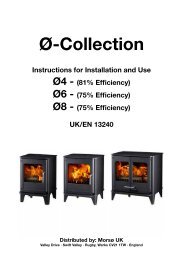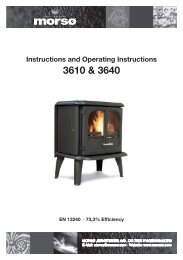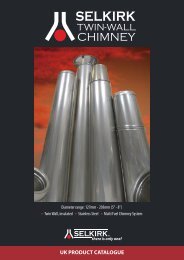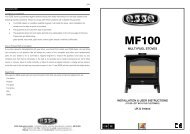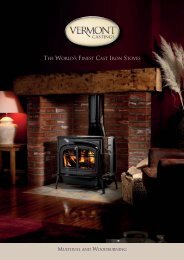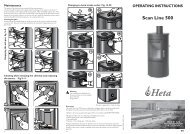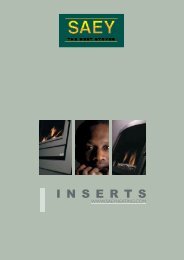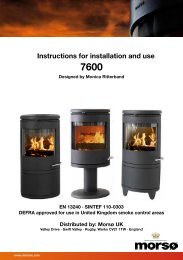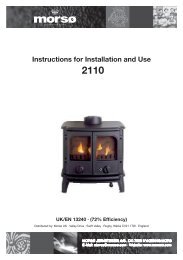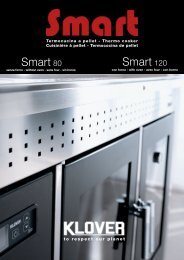View - Stoves Online
View - Stoves Online
View - Stoves Online
Create successful ePaper yourself
Turn your PDF publications into a flip-book with our unique Google optimized e-Paper software.
BIOMASS / MINERAL FUEL<br />
FIREPLACE INSET ROOMHEATER<br />
WITH THERMOSTATIC BOILER<br />
INSTALLATION AND OPERATING INSTRUCTIONS<br />
LEAVE THIS DOCUMENT WITH THE HOUSEHOLDER!<br />
Water<br />
For use only with open-vented, indirect, water systems. Maximum pressure 2 bar. Can be<br />
inter-connected with combi boilers & other heat systems using Esse Centraliser Unit.<br />
Control System:<br />
All-mechanical thermostatic air supply to fire in response to boiler temperature. No electrical<br />
connections or parts. Can be controlled by time clocks, room thermostat etc.<br />
Fireplace & Chimney:<br />
For installation in masonry fireplace with a single dedicated chimney.<br />
Minimum flue draught 14Pa<br />
Clearance:<br />
Physical space: 100mm around in-room parts. From combustibles: 225mm<br />
Extended Burn: Variable with fuel, heat demand and chimney conditions. Anthracite = c12 hrs<br />
MAXIMUM PERFORMANCE With door closed,<br />
burning dry fuel with flue draught of 14Pa<br />
Biomass (Wood Logs)<br />
(With type 395 Boiler)<br />
Mineral Fuel ('Ancit')<br />
(With type 395 Boiler)<br />
Mean flue temperature: * 395 ºC 364 ºC<br />
Flue gas flow: 8.52 g/sec 13.6 g/sec<br />
Mean CO in flue (as if at 13% O2): 0.4% 0.12%<br />
Efficiency: * 75.7 % 72.7 %<br />
Total output from appliance: * 14.7 kW (50,443 Btu) 14.6 kW (49,802Btu)<br />
Output to room: 3.6 kW (12,437 Btu) 2.8 kW (9,714Btu)<br />
Output to water: 11.1 kW (38,006 Btu) 11.8 kW (40,088Btu)<br />
Fuel per hour at maximum: 3.8 kg 2.4 kg<br />
Maximum achieved at refuelling interval of: 1 hr 2hr<br />
* NOTE: Figures are for heat from the appliance only. There will typically be additional, often substantial, heat gains<br />
from the masonry of the fireplace and chimney, and consequent higher total efficiency. Total performance for a<br />
particular building can be calculated by the method of EN13384<br />
Manufactured by: Esse Engineering Ltd<br />
Long Ing, Barnoldswick, Lancashire BB18 6BN, England<br />
www.esse.com<br />
This document, when completed by the installer, constitutes a 'Hearth Notice' for purposes of the England and Wales<br />
Building Regulations 2000, (App. Doc. J4). It must be left with the householder and placed where it can easily be found.<br />
APPLIANCE SERIAL NUMBER:<br />
INSTALLED AT LOCATION:<br />
BY:<br />
EMERGENCY TELEPHONE:<br />
Flue Draught<br />
measured on<br />
commissioning:<br />
Pa<br />
SIGNED:<br />
DATE:<br />
Who certifies that this installation is safe, has been demonstrated to the householder,<br />
conforms with current building regulations and with these instructions<br />
Fuel used on<br />
commissioning<br />
TO FIND A QUALIFIED INSTALLER, FUEL SUPPLIER or CHIMNEY SWEEP, CONTACT:<br />
UK: The Solid Fuel Association, 7 Swanwick Court, Alfreton, Derbyshire DE55 7AS Tel:0845-601-4406 www.solidfuel.co.uk<br />
RoI: Irish Nationwide Fireplace Organisation, 162 Capel Street, Dublin 1 Tel:01-801-5959 www.fireplace.ie<br />
1
Read these instructions! Use only recommended fuels!<br />
Welcome to more than one-hundred-and-fifty years of Esse. You join the illustrious tribe of Esse fire-keepers, from<br />
Florence Nightingale, Captain Scott, Mrs Beeton, Auguste Escoffier, Queen Victoria and most of the Royal Families of<br />
Europe to Fred Dibnah and Hugh Fearnley-Whittingstall.<br />
THIS APPLIANCE BECOMES EXTREMELY HOT AND<br />
CAN PRODUCE POISONOUS GASES.<br />
A fire-guard should be used if children or the infirm are<br />
present. The installer is required to EXACTLY follow<br />
these instructions and to comply with all local, national<br />
and applicable international standards.<br />
An air supply kit is available to bring combustion air directly from<br />
outside the building to the GreenSwitch boiler, greatly reducing the<br />
risk of draughts and significantly improving performance.<br />
TYPICAL INSTALLATION INTO MASONRY CHIMNEY<br />
This is the traditional method used in Britain and Ireland. Other<br />
methods of installation are possible – ask Esse for a leaflet.<br />
LOCATION: This appliance is<br />
heavy, a load distribution plate<br />
may be needed on weaker floors.<br />
The appliance must be located on<br />
a flat hearth extending at least<br />
225mm in front of the fire, and of<br />
suitable material to protect the<br />
building from fire. Combustible<br />
materials, including fuels, must be<br />
at least 225mm away from the<br />
room parts of the appliance. This<br />
stove can fit into fireplace<br />
openings of 400 to 460mm wide and 550 to 590mm high. If the<br />
Outside air kit is used, fireplaces must be prepared with an extra<br />
opening to the lower right of the face, as shown.<br />
YOUR CHIMNEY makes your fire work. It stores surplus heat from<br />
the fire, which makes the gas inside its hollow flue lighter, so that it<br />
rises, pulling fresh air through the fuel and making it burn. The<br />
Greenswitch is for connection to a single flue which must be:<br />
● Able to operate safely at temperatures of up to 500°C<br />
● Free from even the slightest leak, and absolutely incapable of<br />
spilling fumes into the dwelling<br />
● Smooth internally, unobstructed and able to be swept along its<br />
entire length.<br />
● Generate a continuous up-draught in use of at least 14Pa<br />
(0.06insWG)<br />
These ends will often be achieved by the chimney being constructed<br />
entirely of masonry or insulated metal components, having an<br />
internal size of more than 150mm but less than 300mm, being<br />
substantially vertical with no severe bends or horizontal portions,<br />
being at least 5m high and terminating at least 1m above any roof.<br />
AIR SUPPLY. All fuels need a continuous supply of fresh air from to<br />
burn. There must be an air supply into the room from outside the<br />
building, incapable of being closed off and equal to a total of least<br />
55cm² (=c7.5cm square). Leakage around doors and windows is not<br />
always sufficient, while an extractor fan or another fuel-using<br />
appliance, even in a different room, can remove this air and cause<br />
dangerous fume emission.<br />
2<br />
1: Dismantle the boiler. If the unit is supplied assembled, lift off the<br />
top of the front and carefully pull the cylindrical brass thermostat<br />
sensor from its holder. Unfasten the 4 bolts shown, lift the front unit<br />
up slightly and carefully part the two units. Take very great care not<br />
to damage the soft seal.<br />
2: Prepare the setting, fit and test the boiler. Place the boiler/rear<br />
unit on a hearth which will extending at least 250mm in front of the<br />
assembled fire, noting that the final surface of the fireplace will be<br />
just behind the two flanges arrowed. In this example the air supply kit<br />
has been fixed to the side of the boiler with adhesive tape, prior to<br />
being cemented-in. Complete the piping circuit, fill and inspect for<br />
leaks as you won't be able to repair leaks later.
3: Brick up and form the flueway. Build-up a masonry wall around<br />
the boiler, forming a smooth connection to the flue with no ledges<br />
where debris could collect. Fill any space with mortar-and-rubble.<br />
(Shown part-completed)<br />
4: Fit fireplace surround. Slot a ready-made fireplace surround in<br />
place, or build one up using brick, stone or other masonry or metal<br />
materials. Extra fixing, if needed, is through the screw holes shown.<br />
dissipate heat in the event of boiler overheating, irrespective of<br />
how other controls are set.<br />
● Means to completely drain water from the system.<br />
● A means of dissipating surplus heat, such a permanently<br />
connected radiator or hot-water system.<br />
● Means to allow steam to be released in case of complete<br />
thermostat and electrical failure.<br />
In addition, we recommend:<br />
● Radiators fitted with thermostatic valves.<br />
● An 'anti gravity' valve preventing circulation to upper radiators<br />
when the pump is not running.<br />
● A room-temperature thermostat and single-circuit time-clock<br />
controlling the running of the circulating pump.<br />
The diagram shown one possible arrangement.<br />
MULTI-BOILER SYSTEMS with simultaneous automatic control of<br />
the GreenSwitch and gas, oil, cooker-boilers, heat stores, combiboiler<br />
etc. can be achieved using an Esse Centraliser unit. Details<br />
are available separately.<br />
COMMISSIONING The installer must complete the notice at the<br />
beginning of this document, demonstrate the method of lighting,<br />
control and cleaning, and point out the safety requirements to the<br />
householder.<br />
GETTING THE BEST FROM YOUR<br />
5: Refit front and check thermostat: Bolt the door/front unit back in<br />
place, taking great care that the parts seal. Reassemble the interior<br />
fittings and check that the door closes and seals properly. Push the<br />
thermostat sensor fully into its pocket, securing it with a dab of fire<br />
cement. The thermostat is a delicate instrument and, although it is<br />
tested and set at the factory, it may need re-adjusting.<br />
6: Adjusting the thermostat: With the fire cold, the thermostat<br />
sensor vial in place and the thermostat control turned to '1' the air<br />
closure 'damper' plate should be approximately 7 mm open.<br />
HEATING CIRCUIT<br />
Every fuel, chimney and condition of use is different. Only experience<br />
will show which is the best for you. We suggest trying several<br />
different fuels, or mixtures, and different settings of the controls.<br />
GREENSWITCH GETS VERY HOT- Use a glove or the tool supplied<br />
to manipulate hot parts and controls.<br />
LIGHTING After a period of non-use, do<br />
check the chimney for blockages first!<br />
Empty the ashes. Place two or three<br />
firelighters close together, or screwed-up<br />
paper covered with dry sticks, at the<br />
back of the grate and light them. When<br />
they are burning well gently fill the fire<br />
with dry fuel to the level shown. Don't<br />
over-fill or allow fuel to touch the throat<br />
plate.<br />
EMPTYING ASHES Use the tool to pull<br />
the de-ashing mechanism on the right-hand side of the fire back-and<br />
forth. If it jams, don't force it but wait a few minutes for any<br />
obstructing fuel lump to burn away. Open the door and lift out the<br />
ashpan. Let ash cool before disposing in plastic bins. There is no<br />
need to empty every speck, but make sure that ash from mineral<br />
fuels never builds up so that it touches the underside of the grate, or<br />
the grate will melt.<br />
EXTENDED BURNING Allow the fire to burn down to a low, hot fire<br />
bed. Empty the ash and well fill with smaller pieces of hard fuel such<br />
as anthracite.<br />
CLEANING Wipe the body when cool. Soot will condense on the<br />
window if the fuel is damp or if the fire operates at low outputs for<br />
long periods. Deposits will normally burn-off when the next fastburning<br />
cycle comes round, but persistent stains can be removed<br />
with a household bleach spray cleaner when the fire is cold.<br />
DOOR Your GreenSwitch is designed to be operated only with the<br />
door closed. Open the door slowly to minimise fumes emission.<br />
AUTOMATIC CONTROL. Your GreenSwitch has three controls.<br />
The GreenSwitch is for connection to open-vented, indirect, water<br />
systems only, with a maximum working pressure of 2 bar. Every<br />
installation must include:<br />
● A pipe thermostat to prevent the pump running if boiler flow<br />
temperature drops below c50°C. This prevents heat from stored<br />
hot water being dumped if the fire dies down and guards against<br />
condensation inside the boiler.<br />
● A pipe thermostat set at about 90°C to run the pump and<br />
3
1) Boiler thermostat. This senses the temperature of water in the<br />
boiler and automatically allows air in to make the fire burn more<br />
or less fiercely, so that water always leaves the boiler at about<br />
50ºC on setting '1' to about 90ºC at '10'.<br />
2) GreenSwitch control. Simply pull out for wood, push in for<br />
mineral fuels like anthracite.<br />
3) Door air control, a slide or spinwheel fitted on some models for<br />
compatibility with non-boiler versions. Keep it closed at all times.<br />
FUEL must be dry, with no dust or pieces smaller than about 40mm.<br />
WOOD is a renewable fuel, and, because a burning log can't give out<br />
any more carbon than the tree itself absorbed while living, it is<br />
considered to be greenhouse gas 'neutral'. Fresh wood may seem<br />
dry, but its cells are full of water. Burning such 'green' wood wastes<br />
heat in making steam and produces tarry condensation which will<br />
damage your appliance and chimney. Logs should be split and dried<br />
in a well-ventilated place for one to three years. Only ever use<br />
thoroughly dried-out wood. The white residue from burned wood is<br />
not ash, but cell walls which can burn if kept hot enough, so, with<br />
wood alone, don't de-ash the fire until absolutely necessary.<br />
JOINERY WASTE can be a useful fuel if completely dry, but don't<br />
use timber with preservatives as it can emit very poisonous fumes.<br />
PEAT The nearly black moorland or bog peat should be dried and<br />
treated as for wood.<br />
LIGNITE is a mineral between peat and coal. It lights easily and<br />
burns well, though may produce excessive ash and smoke.<br />
ANTHRACITE is a natural hard, shiny, smokeless, form of coal. It<br />
burns with great heat and lasts a long time.<br />
BRIQUETTES are compressed blocks of fuel, generally able to burn<br />
for long periods and remarkable for their consistency.<br />
NOT RECOMMENDED: PETROLEUM COKE is very high in acid<br />
and will damage your appliance. BITUMINOUS HOUSECOAL is<br />
cheap, but rarely value for money, burns with violent flame and tarry<br />
smoke. It will stain the window, is difficult to control and can explode.<br />
HOUSEHOLD WASTE: Plastics create toxic fumes. Batteries &<br />
aerosols explode! Never use liquid fuels.<br />
SMOKE Compliance with smoke regulations is the responsibility of<br />
the user. To ensure low smoke emissions on wood:<br />
1) Make sure the fuel is absolutely dry (less than 15% water)<br />
2) Split logs into pieces no more than about 100mm diameter.<br />
3) Refill 'little and often'<br />
4) Try to load logs 'criss-cross' so that plenty of air can circulate<br />
around them.<br />
It is often beneficial to burn a little clean mineral fuel, such as<br />
anthracite, along with the wood.<br />
SUMMER SHUT DOWN: Before a long period of non-use leave all<br />
the air controls open to allow ventilation to reduce condensation.<br />
PROBLEMS<br />
NOT ENOUGH HEAT Is fuel really dry Is chimney draught correct<br />
Are the room and fire controls set correctly The GreenSwitch is<br />
designed to provide heat into water, when installed in a large room a<br />
radiator will be needed too.<br />
LACK OF CONTROL Are the door seals sound Some types of<br />
wood, lignite and coal are difficult to control.<br />
CONDENSATION happens when water vapour touches a cool<br />
surface inside the fire, mixing with combustion products to make<br />
sticky tar. Water comes from the fuel. Even 'dry' wood may hold a<br />
150mm cupful in every 1kg log. Prevent condensation by using only<br />
absolutely dry fuel and fit the correct thermostat to prevent cold<br />
water from circulating through the boiler.<br />
DIFFICULTY BURNING FOR EXTENDED PERIODS The<br />
GreenSwitch is thermostatic, it will keep on making the fuel burn<br />
vigorously for as long as there is a demand for heat, so, if water still<br />
circulates through radiators eg. at night, the fire will continue to burn<br />
– consider adding an 'anti-gravity' valve to stop unwanted circulation<br />
when the pump is off, or simply turn the boiler thermostat down at<br />
night. Are the door seals sound Is the flue free from cracks For<br />
longest burn use hard fuels like anthracite.<br />
SMOKE COMING INTO ROOM Occasional fumes while loading or<br />
de-ashing may occur, but persistent emission to the room must not<br />
be tolerated. First and always, measure the chimney draught, it must<br />
be at least 14Pa in use. Causes of poor draught include:<br />
LEAKS: Even the tiniest crack in the flue can spoil the draught.<br />
BLOCKED FLUE: Pull out the throat plate to inspect. In any case of<br />
doubt have the chimney professionally swept.<br />
COLD FLUE: Smoke only rises if kept hot. Is chimney fully insulated<br />
LACK OF FRESH AIR: Make sure there is an unobstructed fresh air<br />
supply to the fire.<br />
DOWNDRAUGHT: Wind can blow down the flue if there is something<br />
higher near the chimney such as a tree, hill or high building. Fit an<br />
anti-downdraught cowl to the chimney top.<br />
CHIMNEY FIRE: In the rare event of deposits inside the chimney<br />
igniting (roaring sound + dense smoke and sparks from the chimney)<br />
immediately close the door, shut all air controls and call the fire<br />
brigade. Prevent fires by using very dry fuel and having your<br />
chimney swept regularly.<br />
DIRTY WINDOW. Is fuel absolutely dry The window will become<br />
dirty when the fire operates at low levels for a long time, but will<br />
usually self-clean at higher burn rates.<br />
MAINTENANCE<br />
EVERY MONTH When the fire is cold, use the operating tool to pull<br />
forward and clean the throat plate. Check that the door seals are<br />
sound.<br />
ANNUALLY, or more often if smoky fuels are used. sweep the entire<br />
length of the flue from firebox to chimney outlet.<br />
REPLACEABLE PARTS Internal parts will last far longer if special<br />
care is taken to empty ash from mineral fuels regularly, to clean the<br />
throat plate and to use completely dry fuel. The GreenSwitch has<br />
been extensively tested for safety - please don't try to modify it and<br />
always make sure to get genuine spare parts.<br />
Your GreenSwitch is guaranteed (excluding wearable parts) for one<br />
year from the date of purchase, in addition to your statutory rights.<br />
The Esse 300 and 350, Greenswitch Boiler, the 'Furnesse' 'Chroma' and 'Virtine' door designs are registered at the UK Patent Office and protected by Copyright © and UK<br />
Design Right, Glyn Hughes and the Ouzledale Foundry/Esse Engineering 1994-2009. The Esse 350 'Greenswitch' central heating boiler is UK Patent Applied For. Esse<br />
appliances are forever being developed and improved – your appliance you may differ from the one in this booklet. This document Issued 28/10/2008<br />
4


